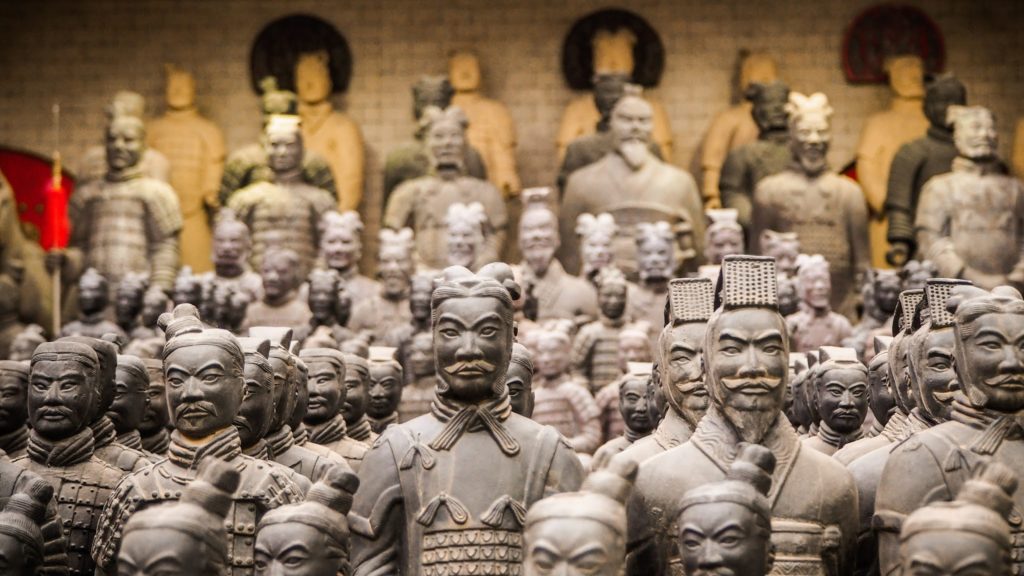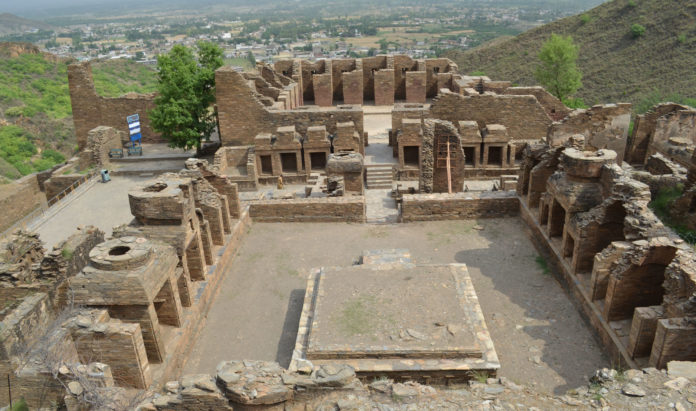The Gandhara civilization existed in what is now Northern Pakistan and Afghanistan from the middle of the 1st millennium BC to the beginning of the 2nd millennium AD. Although multiple major powers ruled over this area during that time, they all had in common great reverence for Buddhism and the adoption of the Indo Greek artistic tradition which had developed in the region following Alexander’s invasions into India.
Gandhara was geographically described in detail for the first time by the Buddhist monk Hsüan-tsang, who travelled in South Asia during 602- 664 AD. That time was the tail end of the Gandhara civilization, the time when it had achieved its greatest feats and was falling into decay. Following ancient Buddhist sources, he described quite accurately the area and its various cities and sites, being the first known account of Gandhara that survives to the modern day and indeed which helped in identifying the remains found in this region during modern times as being of Gandharan origin. Well-known cities of it include Takshasila (Taxila), Purushapura (Peshawar) and Pushkalavati (Mardan), where remains continue to be found to this day.
It has been speculated that Gandhara was a triangular tract of land about 100 km east to west and 70 km north to south, lying mainly to the west of the Indus River and bounded on the north by the Hindukush Mountains. The extent of Gandhara proper actually included the Peshawar valley, the hills of Swat, Dir, Buner, and Bajaur, all of which lie within the northern boundaries of Pakistan. However, the bounds of Greater Gandhara, i.e. regions where the cultural and political hegemony of Gandhara held sway, extended towards the Kabul Valley in Afghanistan and the Potohar plateau in the province of Punjab in Pakistan. Indeed, during certain times, the influence spread as far as Sindh where remains of a stupa (Buddhist place of worship and meditation) and a Buddhist city are still visible, built over the even older remains of Mohenjodaro.
The name of Gandhara may have several meanings, but the most prominent theory relates its name to the word Qand/ Gand which means “fragrance”, and Hara which means ‘lands’. Hence in its simplest form, Gandhara is the ‘Land of Fragrance’.
Gandhara was briefly part of the Persian Empire of Achaemenids but that occupation did not last long. Later on, it was instead known to be a tributary state of the Achaemenids and paid tributes while retaining a certain autonomy. The Achaemenid hegemony in Gandhara lasted from the 6th century BC to 327 BC. Alexander while conquering Persia is said to have crossed through Gandhara to enter into Punjab proper and was offered alliance by the ruler of Taxila against his enemy, Raja Porus, who was a constant source of agitation for Taxila and its regions of influence. This culminated in the famous battle against Porus at the Jhelum in 326 BC. Nonetheless, Alexander’s stay in India was short, and he eventually ventured south along the Indus River, crossing west over into Balochistan and onward into Persia, where he met his demise.
By 316 BC, King Chandragupta of Magadha, southern Bihar, (321-297 BC) moved in and conquered the Indus Valley, thereby annexing Gandhara and naming Taxila a provincial capital of his newly formed Mauryan Empire. Chandragupta was succeeded by his son Bindusara, who was succeeded by his son Ashoka. Ashoka later converted to Buddhism and famously propagated the spread of this new religion by building multiple monasteries and spreading the edicts of his “Dharm” across the subcontinent. One of these is the grand Dharmarajika monastery east of the river Tamra at Taxila, famous for its stupa, and it is said Ashoka buried several relics of Buddha there.
In 184 BC, the Greeks (who had remained strong in Bactria, modern North Afghanistan), invaded Gandhara again under king Demetrius, and it was he who built a new city on the opposite bank of the river from Bhir Mound. This new incarnation of Taxila is known now as Sirkap meaning ‘severed head’. The Kingdom of Demetrius consisted of Gandhara, Arachosia (modern-day Kandahar in Afghanistan), the Punjab, and a part of the Ganges Valley. It was a multi-ethnic society, where Greeks, Indians, Bactrians, and Western Iranians lived together. Evidence of this is found all over 2nd-century BC Taxila, such as a Zoroastrian sanctuary at Jandial, directly north of Sirkap.

The gradual takeover of the Punjab by the nomadic Scythians of Central Asia began around 110 BC. These tribes had been accustomed to invading northern territories such as those in Bactria but had been kept back by the Achaemenids in the past. They had settled in modern-day Sistan in Iran and invaded Punjab, infiltrating through the southern Indus Valley, eventually taking over Taxila. In the first quarter of the 1st century AD the Iranian Parthians moved in and began taking over the Greek kingdoms in Gandhara and Punjab. Gondophares, a Parthian leader who lived at Taxila is said to have been baptised by the apostle Thomas, not a wholly impossible claim since the city already hosted a number of religious faiths and might have accommodated a fledgling Christian one nearly 2000 years ago.
The Kushans became the next ruling elite; they were a tribe that migrated to Gandhara around the 1st century AD from Central Asia and Afghanistan. The tribe selected Peshawar as its seat of power and later expanded east into the heartland of India to establish the Kushan Empire, which lasted until the 3rd century AD. In 80 AD, the Kushans wrested control of Gandhara from the Scytho-Parthians. The main city at Taxila was again re-established at another site and the new name Sirsukh given to it. It resembled a large military base, with a wall 5 km long and 6 metres thick. It now became a hub of Buddhist activity and hosted pilgrims from Central Asia and China. The Kushan era is the high point of Buddhist Gandhara art, architecture, and culture and considered a golden age in the history of this region.
The tail end of the Kushan rule saw a succession of short-lived dynasties taking over control of the Gandhara region, and this resulted in a situation where the region was constantly being raided, invaded or in some way or other in turmoil. A quick succession of rule by the Persian Empire of Sassanids, Kidarites (or little Kushans), and finally the White Huns following the weakening of Kushan rule led to day-to-day religious, trade, and social activity coming to a standstill. In about 241 AD, the rulers of the area were defeated by the Sassanids of Persia and Gandhara became annexed to the Persian Empire again. However, under pressure from the northwest, the Sassanians could not directly rule the region and it fell to descendants of the Kushans, who came to be known as the Kidar Kushans. They managed to hold the region, carrying on the traditions of their Kushan predecessors up to the middle of the 5th century AD when the White Huns invaded the region. As Buddhism and by extension Gandhara culture was already at an ebb by this time, the invasion caused physical destruction, and due to the Huns’ adoption of the Shivite faith, the importance of Buddhism began to wane fast. During the White Hun invasions in the 6th c. AD, the religious character of the region shifted gradually towards Hinduism and Buddhism was shunned in its favour, as it was deemed politically expedient by the White Hun who sought to make alliances with the Hindu Gupta Empire against the Sassanids. The change in the Buddhist character of the region that had been the basis of all social life for centuries, led to a further decline of the Gandhara region.
For centuries Gandhara culture was forgotten. In the 19th century, British soldiers and administrators started taking an interest in the ancient history of the Indian Subcontinent. In the 1830s coins of the post-Ashoka period were discovered, and in the same period Chinese travelogues were translated. With the Gandharan culture in Afghanistan unprotected for religious reasons, it is the task of Pakistan to uphold the Buddhist culture of Gandhara as a world heritage. Especially the attempts of the Afghan Taleban to erase Buddhist statues and similar attempts in the northern areas of Pakistan it is important to fight against views that Buddhism was “unislamic”. It preceded Islam and the strong notion of equality of men in Buddhism was a reason why former the Buddhist population opened up to and converted to Islam when it entered the subcontinent. Buddha should be recognized as a Prophet within the long line of countless Prophets all of whom are recognized and revered in Islam. Teaching pre-Islamic history in schools and universities can further this understanding.
Contributed by:

former Professor of South Asian Studies, Humboldt University, Berlin, Editor of the Defence Journal and a Consultant to the Pathfinder Group).





